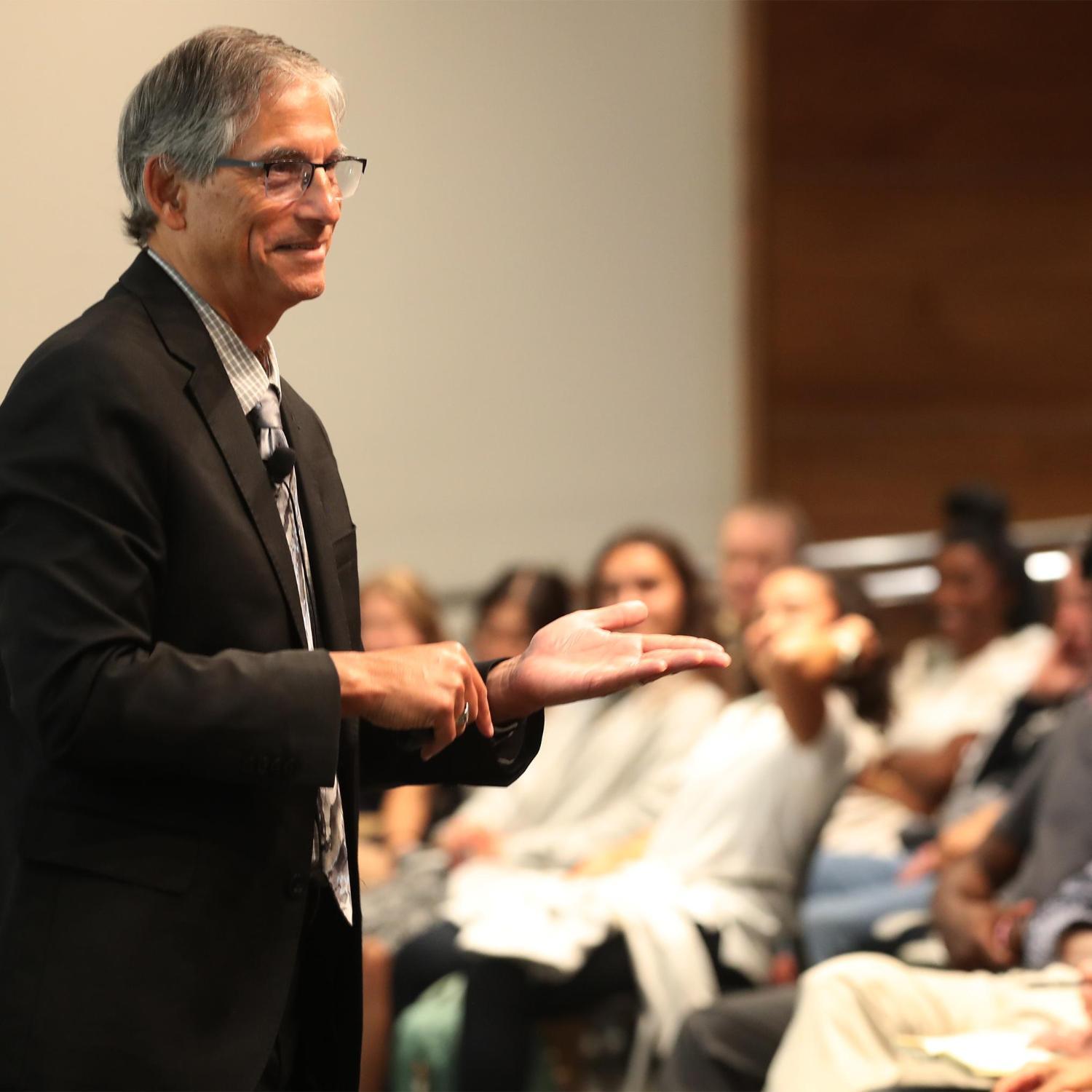Sep 16, 2025
Lamb Lecturer calls for ‘expertise without borders’

At this year’s Robert L. Lamb Distinguished Lectureship, Rob Landel, DPT, challenged VCU physical therapy students to seek out opportunities to specialize – but learn to cross lanes because therapists can best help patients when they do.
After all, today’s cases from post-concussion dizziness to long COVID are getting increasingly more complex. Meeting them will require clinicians who refuse to choose between depth and breadth.
“If you stay in your lane, then who gets left behind? Your patients are going to be the ones left behind,” said Landel, a professor of clinical physical therapy at the University of Southern California. “They need all of you, not just part of you.”
Established about a decade ago to honor the late Robert L. Lamb, a VCU PT leader renowned for scholarship, editorial service and association leadership, the lecture recognizes impactful contributors to physical therapy research and practice and gives VCU Physical Therapy students a chance to learn directly from the profession’s change-makers. This year’s lecture was held Sept. 9 at the College of Health Professions.
Landel acknowledged that his career has been spent in pursuit of clinical excellence and advocating for clinical specialization. But that created a paradox that he’s wrestled with for decades, in that specialization is essential, but not sufficient – and he’s seen it play out on the front line with his own patients.
Landel framed that struggle within his own professional journey, starting with neurologic rehab at Los Angeles’ highly regarded Rancho Los Amigos to outpatient orthopedics, explaining how those experiences forced him to “straddle the line” between neuro and musculoskeletal care. Over time, that hybrid lens led him to one of his signature topics: cervicogenic dizziness (pain caused by issues in the neck), particularly after concussive events.
His thesis for the afternoon was crisp: Find your specialty and pursue excellence, but don’t let it box you in.
“Specialization isn’t the goal,” said Landel, an award-winning teacher who has trained therapists and physicians on five continents. “Specialization risks building walls around expertise.” Complex cases rarely respect neat categories, and the profession’s siloed structures can unintentionally leave patients behind, he said.
Dizziness as a proving ground for collaboration
Landel’s current clinical research focuses on cervicogenic dizziness, and more specifically, the diagnostic dilemma and management challenge posed by patients with persistent post-concussion dizziness.
Today’s concussion care regularly spans musculoskeletal, vestibular, neurologic, autonomic, ocular and psychosocial domains. He challenged a brain-only frame of reference for concussion symptoms, pointing to the biomechanics of injury and everyday clinic patterns.
“It’s hard for me to think of a way that you could suffer a blow hard enough to injure the brain that wouldn’t also injure the neck,” he said, arguing that a concussive event often loads the cervical spine and the vestibular system (the body’s balance center) alongside the brain.
The practical implication: evaluate and treat all likely contributors and sequence care based on symptom severity. For example, he’d suggest calming a patient’s painful neck before ramping up vestibular exercises that require an individual to move their head.
Landel illustrated how clinical reasoning tools – such as head-neck differentiation to tease neck-driven provocation from head-movement provocation – and highlighted evidence for combining manual therapy, vestibular rehabilitation, sensorimotor retraining and graded exertion. The outcome data he presented underscored a key point: Integrated approaches outperform isolated ones.
Co-author of the current PT practice guidelines for post-concussion care, Landel is pioneering this research at USC’s Herman Ostrow School of Dentistry, where he also directs the clinical residency and fellowship programs after leading the DPT program for 11 years. He was founder and first director of the division’s faculty practice, treating patients with primarily orthopedic, neurologic, balance and vestibular dysfunctions. Like Lamb, Landel is a Catherine Worthingham Fellow of the American Physical Therapy Association.
The mindset behind the method
Landel’s larger message looked at how physical therapists train and then work together as care providers. Early-career clinicians, he said, should absolutely become specialists, but then keep going because “that’s not the end of it,” he said. “That’s just a start.”
Specialization drives a single focus, which is an admirable intent but can create limitations. By championing collaboration and cross-training, as future PTs, you can “empower yourself to blur the lines, because your patients already do that.”
For experienced clinicians, he pushed for cultures that reward integration, such as residency and fellowship structures that convene ortho, neuro, sports, pediatrics and cardiopulmonary perspectives around shared problems including concussion and persistent pain.
In building what he called a hybrid clinical identity, which means competence across adjacent domains, clinicians can develop treatment plans that adapt to multi-system problems.
As he put it: “Patients don’t care what your title is. They only care what you can solve.”